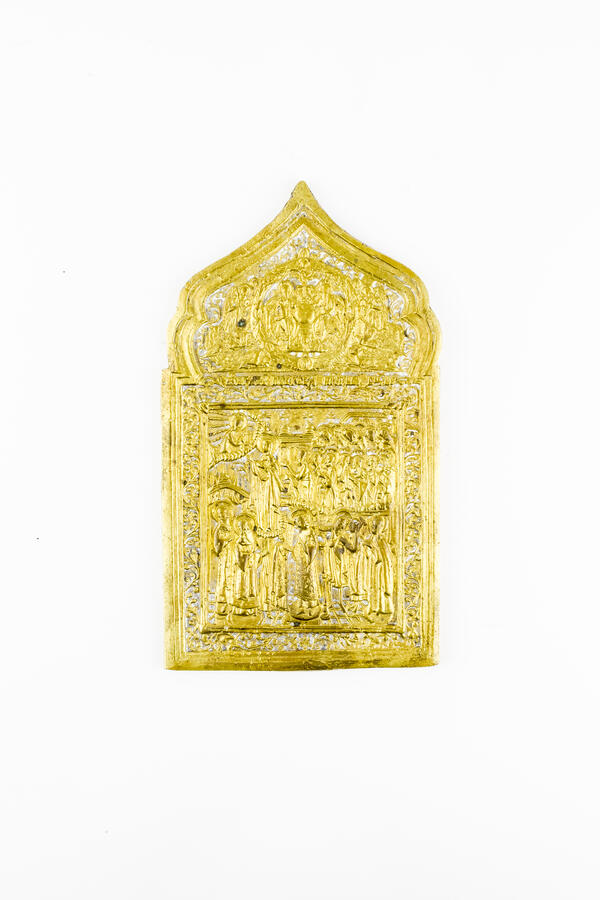Copper casting appeared in Russian church art as early as the 11th–12th centuries, before the Mongol invasion of Kievan Rus. It experienced a revival at the turn of the 18th century, when metal icons, winged altarpieces and various crosses were created mainly by Old Believers.
It is easy to explain why casting was popular in this particular social group: the state had been persecuting this part of Orthodox Christians for 250 years. They constantly had to move all their belongings to new places, and large church icons were not suitable — they fell, cracked, broke, the paint layer crumbled, it was difficult to hide them when the Old Believers’ homes were searched. Small cast icons were more convenient for travel, when people had little time to gather their belongings.
Therefore, copper casting flourish in the Old Believer communities, especially in those Pomor settlements, where believers had completely abandoned the idea of priesthood. The artists achieved the highest level of skill and enriched the familiar scenes with many different variants.
The icon “The Intercession of the Most Holy Theotokos” is traditional for all Orthodox Christians, it is popular among the Old Believers as well as among those who accepted Patriarch Nikon’s reforms. The icon is based on the story of Andrew the Fool telling how the Mother of God appeared in the in the Blachernae church during the siege of Constantinople. As with many icons of this type, there are two levels in this case: the earthly and the heavenly one.
In the lower part, the artisan depicted a temple with people praying, with Andrew the Fool among them. He calls his disciple Epiphanius and points to heaven. There is Romanos the Melodist, who received a special gift to compose church hymns from the Virgin. He has nothing to do with the church holiday of the Intercession of the Mother of God, but he is often depicted on the icons of the Intercession because he wrote a special hymn in honor of the Virgin — an akathist to the Annunciation of the Mother of God. It is performed on the fifth Saturday of Great Lent. In the upper part, the Virgin Mary is surrounded by saints, she holds a cover — a symbol of the protection extended over people.
The copper icon from the museum collection features a late iconographic version of this narrative. Unlike old icons, this one depicts the Mother of God not in the center of the composition, but on the left side. And Her figure is depicted half-turned.
It is easy to explain why casting was popular in this particular social group: the state had been persecuting this part of Orthodox Christians for 250 years. They constantly had to move all their belongings to new places, and large church icons were not suitable — they fell, cracked, broke, the paint layer crumbled, it was difficult to hide them when the Old Believers’ homes were searched. Small cast icons were more convenient for travel, when people had little time to gather their belongings.
Therefore, copper casting flourish in the Old Believer communities, especially in those Pomor settlements, where believers had completely abandoned the idea of priesthood. The artists achieved the highest level of skill and enriched the familiar scenes with many different variants.
The icon “The Intercession of the Most Holy Theotokos” is traditional for all Orthodox Christians, it is popular among the Old Believers as well as among those who accepted Patriarch Nikon’s reforms. The icon is based on the story of Andrew the Fool telling how the Mother of God appeared in the in the Blachernae church during the siege of Constantinople. As with many icons of this type, there are two levels in this case: the earthly and the heavenly one.
In the lower part, the artisan depicted a temple with people praying, with Andrew the Fool among them. He calls his disciple Epiphanius and points to heaven. There is Romanos the Melodist, who received a special gift to compose church hymns from the Virgin. He has nothing to do with the church holiday of the Intercession of the Mother of God, but he is often depicted on the icons of the Intercession because he wrote a special hymn in honor of the Virgin — an akathist to the Annunciation of the Mother of God. It is performed on the fifth Saturday of Great Lent. In the upper part, the Virgin Mary is surrounded by saints, she holds a cover — a symbol of the protection extended over people.
The copper icon from the museum collection features a late iconographic version of this narrative. Unlike old icons, this one depicts the Mother of God not in the center of the composition, but on the left side. And Her figure is depicted half-turned.



